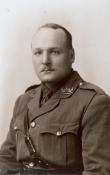
War Memorial
| Lieutenant Frank Savill TOMKINS | |
|
9 Platoon, C Company, 7th (Service) Battalion Gloucestershire Regiment Date of birth: 28th August 1885 Date of death: 8th August 1915 Killed in action aged 29 Commemorated on the Helles Memorial Panel 10 |

|
| Frank Savill Tomkins was born at Caterham on the 28th of August 1885 the son of Alfred Savill Tomkins, a merchant, and Margaret Louise (nee Cracknall) Tomkins of “Holmwood”, Caterham Valley, Surrey. He was christened at St Mary's Church, Caterham on the 20th of October 1885. He was educated at Hazelwood School until July 1898 where he was a member of the Choir. On leaving the school the magazine wrote the following on him: - "...... goes to Marlborough, and will do well in whatever form he is placed." He went on to Marlborough College where he was in Summerfield House from the 1st of September 1898 to Easter 1902. He started practicing as a solicitor at 3 Raymond Buildings Grey’s Inn in October 1908 and lived at Flat 1, 46 Elgin Crescent, Ladbroke Grove. He qualified in all subjects for the Consular service in 1910. Following the outbreak of war he enlisted at 10 Stone Buildings, Lincolns Inn as Private 1567 in the Inns of Court Officer Training Corps on the 6th of October 1914. At a medical examination, which had been held on the 30th of September, it was recorded that he was five feet ten inches tall and that he weighed 183lbs. He was posted to E Company at Berkhamsted for training. He applied for a commission on the 7th of November 1914 and was commissioned as a 2nd Lieutenant in the Gloucestershire Regiment on the 27th of November 1914, being promoted to Lieutenant in March 1915. On the 8th of August 1915 the 7th Battalion Gloucestershire Regiment was detailed to be part of an attack on Chunuk Bahr at Gallipoli. They moved to the attack at 4.15am on the left of the Wellington Battalion. B and D Companies were leading the attack with A and C in the second wave. According to the war diary they came under heavy enfilade fire from the left and the leading platoons “were practically wiped out”. William Ewing, serving as a Chaplin on Gallipoli, wrote in his diary:- “In the early morning of the 8th, the crest of Chunuk Bahr was captured. A unique and glorious record is that of the 7th Gloucesters, a regiment of the New Army. Every officer and NCO was either killed or wounded. Reduced to a few small groups of men, commanded by junior NCOs and Privates, they fought dauntlessly from midday until sunset.” The war diary records it taking three days before all the survivors returned to the unit. Casualties were 3 officers killed with 8 wounded. 45 other ranks killed with 115 wounded and 119 missing. Frank Tomkins was reported as wounded and missing after the attack. His sister Mary received the following telegram dated the 12th of August 1915: - "Deeply regret to inform you that 2 Lieut. GF.S. Tomkins Gloucester Regt. is reported from Alexandria wounded believed killed 8th August. Lord Kitchener expresses his sympathy." A series of interviews with survivors from the attack were gathered in order to establish the fate of Frank Tomkins. Interview with Private 10829 A. Lloyd 7th Batt. Gloucester Regt. taken at 5th Southern General Hospital, Fawcett Road, Southsea on the 14th of October 1915: - "Informant states that Lieut. F.S. Tomkins was killed in action on Aug. 8th and that he saw his body." Interview with 2nd Lieutenant R.L.L. Caunter 7th Gloucesters taken at Alexandria on the 15th of October 1915: - "Early morning 8th Aug. after taking Chunuk Bahr, Hill 971, advanced to attack as far as possible. He was telling his men to "dig in" and got hit through the shoulder or arm. He still went on and two minutes afterwards was hit through the body. he fell over an edge and probably remains there." Interview with Private 10515 E. Reid D Company, 7th Gloucester Regt. taken at Glymenopulo Convalescent Camp, Alexandria on the 15th of December 1915: - "Reid states that Lieut. Tomkins was killed. Pte. T. Wagner Stretcher Bearer, 7th Gloucesters D Company carried Lieut. Tomkins from the trench and could give all particulars. Wagner is now at Gloucester, having left the Peninsular some time ago, sick." Interview with Private 10971 W. Sharp Gloucester Regiment taken at 3rd Southern General Hospital, Sommerville College, Oxford on the 1st of February 1916: - "Informant states that on 7th August 1915 at Anzac, the Gloucester Regiment went out in a big attack. They were very badly cut up, losing 800 men in a few hours. Lieut. Tomkins was in the attack and did not return. Our men went out on the 9th to try to identify the bodies, but the Turks had been out first, had taken most of the identity discs and had stripped many of the bodies and identification was impossible in most cases. There was practically no chance of nay having been made prisoners" Interview with F.H. Baird, Stretcher Bearer, 7th Gloucester Regt. taken at the Canadian Hospital, Taplow on the 8th of February 1916: - "Informant states that on Aug. 8th 1915 about 9pm, at Anzac, he was stretcher bearer and carried Lt. Tomkin (sic) to the 4th Australian Dressing Station, where he put him on a blanket and covered him and left him. One of the hospital staff whom informant did not know afterwards told informant that Lt. Tomkins had died about 3 o'clock in the morning. His name as informant knew it was Lt. Tomkins, C Company, 9th Platoon, 7th Gloucester Regt." His sister, who was working as a nurse at the Military Hospital, Salisbury, made a number of enquires of the War Office including one suggesting that he might be a prisoner of war and that he may have lost his memory. In response she received a letter dated the 29th of December 1915: - "The American Embassy at Constantinople regrets to report that according to an official communication from the Turkish Foreign Office under date of December 25th 1915, nothing is known of the date of the above named officer." He was officially declared as having been killed in action on the 8th of August on the 16th of May 1916. He is commemorated on the war memorial at Marlborough College. |
|
| Went on to Marlborough College |
Back